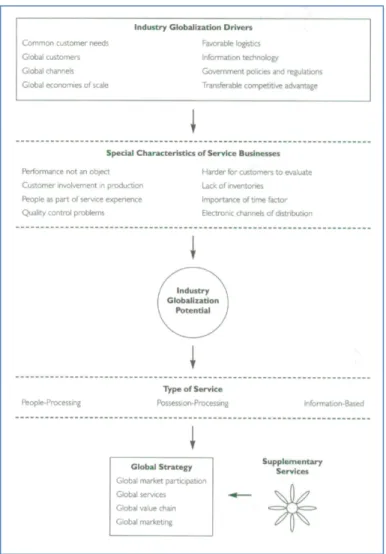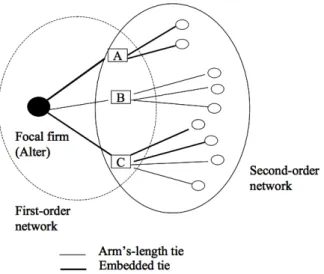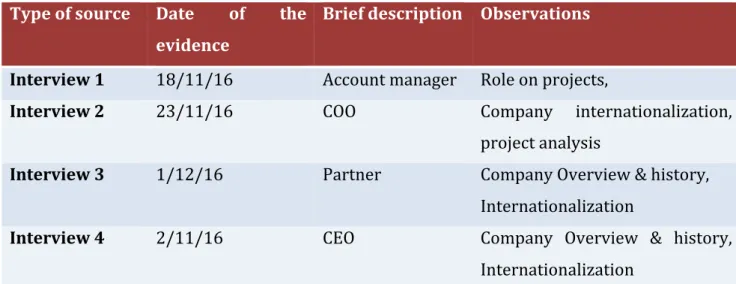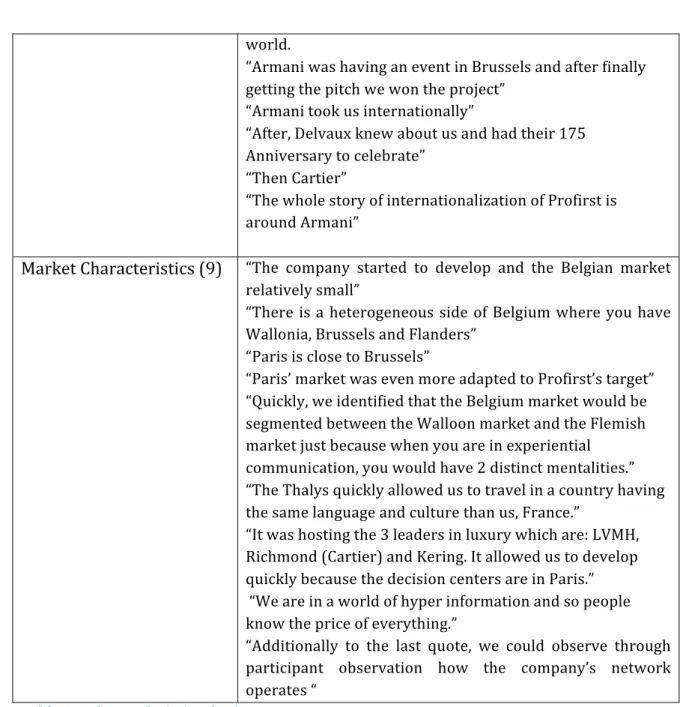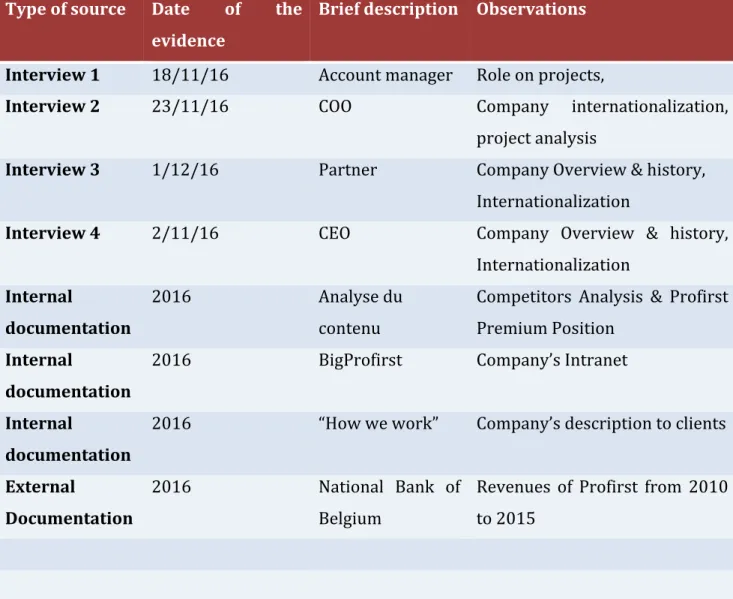Internat
iona
l
izat
ion
strateg
ies
in
the
serv
ice
industry
A
Case
Study
o
f
Pro
f
irst
Internat
iona
l
Haro
ld
P
ir
lot
de
Corb
ion
152115113
D
issertat
ion
wr
itten
under
the
superv
is
ion
o
f
Laure
Leg
l
ise
D
issertat
ion
subm
itted
in
part
ia
l
fu
l
f
i
lment
of
requ
irements
for
the
MSc
in
Management
,
at
the
Un
ivers
idade
Cató
l
ica
Portuguesa
,
4
tho
f
January
2016.
Abstract
English
This dissertation explores the internationalization of a service company. It also observes the different internationalization theories with an emphasis on the network perspective. The main goal of this research is to understand why networks can help small and medium enterprises when they are internationalizing.
First, the study is built on data collected from four in-‐depth interviews and participant observation of a Belgian company, Profirst International. We also collected internal documentation to use secondary data.
The results of this dissertation demonstrate that networks are used to access new resources and identify opportunities. Additionally, some types of company need to have an extensive network for their corporate identity. Finally, network relationships related to social capital are essential to expand internationally. Overall, the findings reflect that networks are one attribute that international companies must possess.
Portuguese
Esta dissertação explora a internacionalização de uma empresa de serviços. Igualmente observa a perspectiva da rede e como se relaciona às oportunidades da internacionalização. O objectivo principal desta pesquisa é perceber como é que estas redes podem ajudar pequenas e médias empresas aquando da internacionalização.
Primeiramente, o estudo é baseado na recolha de dados de quatro extensivas entrevistas e uma observação participativa de uma empresa Belga, Profirst International. Também recolhemos documentação interna para utilizar como segundo plano.
Os resultados desta dissertação demonstram que as redes são usadas para aceder a novos recursos e oportunidades. Ainda, algumas destas empresas necessitam de uma extensiva rede para a sua identidade corporativa. Finalmente, redes relacionais relacionadas com o capital social são essenciais para a expanção internacional. No fundo, esta pesquisa revelou que estas redes são um atributo fulcral que todas as empresas internacionais devem ter
Table of contents
Abstract ... 2
English ... 2
Portuguese ... 3
List of Figures ... 5
List of Tables ... 5
1 Introduction ... 6
2 Literature Review ... 10
2.1 The service and its characteristics ... 10
2.2 The types of services and their internationalization ... 11
2.2.1 Hard and soft services ... 12
2.2.2 Lovelock and Yip’s classification ... 13
2.2.3 The Supplementary Services ... 15
2.3 The network theory ... 17
2.3.1 Networks ... 17
2.3.2 Network perspective in internationalization ... 18
2.4 The use of networks for internationalization ... 20
2.5 Networks and Social Capital ... 21
3 Methodology & Research Proposition ... 25
3.1 Research Design ... 25 3.2 Data Collection ... 26 3.3 Data Analysis ... 28 4 Case Study ... 33 4.1 Introduction ... 33 4.2 Profirst International ... 33
4.3 The service of Profirst ... 37
4.4 The Internationalization Process at Profirst ... 38
5 Findings ... 40
5.1 Build relationships and a reputation ... 40
5.2 Gain a competitive advantage ... 41
5.3 Create and accelerate opportunities ... 42
6 Discussion ... 45
6.1 Build relationships and a reputation ... 45
6.1.1 International opportunities ... 45
6.1.2 Project accomplishment ... 46
6.1.3 Learning advantage ... 47
6.2 Gain a competitive advantage ... 49
7 Conclusion ... 52 7.1 Future Research ... 53 7.2 Limitations ... 53 8 Bibliography ... 54 9 Appendixes ... 60
List of Figures
Figure 1: Globalization Framework for Service Businesses (Lovelock and Yip, 1996;
p.67) ... 15
Figure 2 Supplementary Service (Lovelock & Yip, 1996; p.70) ... 16
Figure 3: Network Composition (Arenius & Jones, 2003; p.10)……….18
Figure 4: Profirst organigram (Author) ... 35
Figure 5: Profirst service analysis (Author) ... 37
Figure 6: Research question answer (Author)………. 51
Figure 7 The Carpentry Office Space (Author) ... 61
List of Tables Table 1: Interviews Table (Author) ... 27
Table 2 Codes Analysis (Author) ... 32
Table 3: Profits and revenues over the last 4 years (in euros) Source: Author ... 37
Table 4 Phases and steps of a project at Profirst (Author) ... 38
Table 5 Case Study Data Base (Author)... 60
1 Introduction
The globalization, the evolution of technologies and communication tools are the origin of the internationalization phenomenon. Internationalization can be defined as “the process by which firms both increase their awareness of the direct and indirect influences of international transactions on their future, and establish and conduct transactions with other countries” (Beamish, 1990, cited in Coviello & Munro, 1997, p.362)
While globalization consists in a threat for increasingly competitive enterprises, it also creates opportunities for companies to adapt to an ever-‐changing environment. Distance is no longer an obstacle and the company can, through internationalization process, have access to skills, talents and production costs that were not accessible in the past.
Buckley and Ghauri (2004) suggest that globalization in many industries offers new opportunities and challenges to companies regarding their international development. Indeed, internationalization processes and strategies became ubiquitous in business research topics also due to important outsourcing trends in the value chain of many industries. (Pla-‐Barber & Ghauri, 2012). Through internationalization, companies will be asked to gain a more sophisticated decision making process but that will also to fine-‐tune their activities. This mainly occurs when they take advantage of their location but also focus on what there are best at, their competitive advantage.
Globalization and internationalization are terms of the corporate world but does not concern only corporation. Surely it does have impacts on small and medium enterprises (SMEs). Such enterprises can relate to all sectors if they do not surpass a particular size. The European Commission (2008) determines companies being a SME under the following conditions:
1) Micro enterprises having a staff below 10 people and a turnover below €2 million
2) Small enterprises having a staff below 50 people and a turnover below €10 million
3) Medium enterprises having a staff below 250 people and a turnover below €50 million
SMEs and large corporations are now both concerned about internationalization and experience the same issues while having different core characteristics. Indeed, SMEs are characterized by flexibility and limited budget while MNEs have access to knowledge and resources but a traditional structure.
In a globally competitive world, SMEs striving for an international presence are pilling up new challenges to existing ones (Zain & Ng, 2006). They are entering new markets where they lack knowledge and are constrained on resources access. However, facing such difficulties, SMEs can be helped and can engage in networks with customers, distributors, suppliers, and competitors to develop trust and commitment in the new markets (Tang, 2001; Ojala, 2009). The internationalization of SMEs has already been investigated in previous research (Coviello & Munro, 1997; Johanson & Vahlne, 1992; Ojala, 2009; Zain & Ng, 2006) and one can conclude that SMEs can suffer from a lack of resources or credibility compared to multinationals. Nevertheless, Lu & Beamish (2001) show that internationalizing from a network perspective can seriously reduce these problems.
A network in a business context represents the exchanges between all the stakeholders of a company creating relationships and the internationalization possible (Zain & Ng, 2006). Such networks replacing traditional strategies (Andersson & Helander, 2009) could offer the firms a facilitated market-‐entry.
According to Tang (2001), the relationships’ strength influences the network perspective and will therefore impact the firms’ potential to discover opportunities and facilitate the business development. In this context, relationships can either be related to business activities (formal) or to personal contacts such as family and friends (informal) (Ojala, 2009)
As mentioned above, the influence of networks on SMEs’ internationalization has already been analyzed but we are interested to focus on the service industry and the
importance of the interaction between these relationships. Ojala (2009), Zain & Ng (2006), Coviello & Munro (1997) that also studied the subject focused only on a specific industry and called to investigate on a different one.
Surely, this thesis seeks to deepen existing literatures on networks and internationalization by studying why SMEs in the service industry engage in networks when internationalizing.
Our analysis will be guided by the following research question:
Why do SMEs in the service industry engage in networks during their internationalization?
This research tries to enhance what is known about internationalization of the service industry through networks because there is a gap in the literature. Indeed, many researches have focused on networks and internationalization (Coviello & Munro, 1997; Tang, 2011; Zain & Ng, 2006; Ojala, 2009) while others focused more on service firms and internationalization (Buckley et al., 1992; Saeed, 1999; Miozzo & Soete, 2001; Ball et al., 2008; Boehe, 2015; Meyer et al., 2015;Gronroos, 2016). In this thesis, we will link service firms, internationalization and the network perspective all together in one research to observe the inter dependence between these factors.
The service sector catches our attention for two reasons. First, the growing importance of the service industry has generated interests over the past decades (Naipaul & Parsa, 2000; Sundbo et al., 2001; Heshmati, 2003). Indeed, service industry has been increasingly important in the European regions and is now outweighing the manufacturing industry in several European countries. Secondly, in regard to globalization the economy tend to be more focused on information and “service” goods rather than production goods (Meyer & Kirby, 2012).
This thesis will have four different parts concerning internationalization strategies and the service industry.
The first part concerns the literature review needed to have the necessary background to establish our research. This consists mainly of services’ characteristics and the network perspective. The first goal of the literature review is to define a service and its characteristics. Next, we analyze different concepts in relation to internationalization. Finally, we will further analyze the network perspective, as this approach will help us to answer our research question.
The next part consists of the research methodology used to develop this study and answer the research questions. The goal is to find a methodology that will offer additional information to existing studies but also explain the origin of the findings.
The following part consists of a case study about Profirst International. An event company based in Brussels, Paris and London but present in many other cities of the world. This part will allow us to connect the literature to a real life example but also to adapt some research to the service industry.
The final part includes the findings from the interviews conducted with different employees of the company. Next to our findings, we found it important to discuss our findings with the existing literature on the thesis subject. Additionally, we touched upon some topics that could be used for future research. This document will be closed by the limitations of the study and an overall conclusion covering the different part of the research.
2 Literature Review
As explained in the introduction, this research focuses on the internationalization of a service company. The goal of the literature review is to clear up important concepts of this dissertation and also identify the gap in the literature explained above that we are willing to fulfill. First, we analyze the concept of a service and introduce it in the context of internationalization. Next, we explore how networks are an important perspective when a firm internationalize. Finally, we summarize the literature review and interpret the initial gap observed in the literature.
2.1 The service and its characteristics
Before starting to investigate about the service industry, it is important to point out a key difference for this research: the difference between goods and services.
Goods are products, which have to be manufactured, stored, transported, marketed and sold. The difference that stands out between goods and services is their tangibility. Goods are normally tangible in nature whereas services are intangible. (Bouncken, Schuessler & Kraus, 2015)
On the other hand, services are outputs of people in an organization and they can either be a collective or individualistic performance or action by an individual. For instance, a hairdresser’s focus is giving individual services. Private ships, on the other hand, can qualify to be categorized as both goods and services. Indeed, the actual ship is a good, but travelling on board of the ship is a service (Slack, 2015).
According to Blut et al. (2014), we can define a service based on four characteristics:
1) Intangibility
Tangibility emanates from the word “touch”. Therefore, services cannot be touched, held or seen before the decision of purchase. This means that they should be made tangible to a certain extent.
2) Inconsistency
The term of inconsistency is the fact that the action cannot be repeated the same way several times. In this context, this means that the quality of a service can be inconsistent and vary from one to another. This is because there is variation in performance everyday from one person to another especially when they have different capabilities. Inconsistency in quality of service can be reduced by mechanization, training and standardization.
3) Inseparability
Production of services and its consumption are simultaneous. Therefore, the provider of the service cannot be separated from the service itself. The service provider and customer interaction varies based on physical presence of the consumer to receive the service.
4) Inventory
Inventory relates to raw materials or stock, meaning that services cannot be stored. Due to the intangibility of services, there is no maintenance of inventory for services. A service is thus the delivery of activity that cannot be saved (Sundbo et al., 2010).
2.2 The types of services and their internationalization
In this second part of this literature review we will analyze the service industry in the context of the internationalization. Service companies possess different characteristics from non-‐service-‐based companies, affecting their process of internationalization. Therefore, it is important to point out the differences between service and product internationalization.
As explained above (cfr. 2.1 the service and its characteristics), a service is intangible, nonstorable and untransportable, which reduces the options for distribution and export (Menzies and Orr, 2013). The difference in nature of a services compared to a
product is that services integrates its context, process and outcomes (Sundbo et al., 2010). Therefore, the internationalization of a service is an undeniable challenge for the concerned companies.
2.2.1 Hard and soft services
While Blut et al. (2014) generally describe a service by four main characteristics, we can distinguish the services in two distinct categories namely the hard services and the soft services. The hard services will differ from the 4 I’s mentioned above because the production of hard services can be separated from its consumption. This enables independence between the consumer and the producer. We focus on the definition of Ball et al. (2014) since the service industry is very broad and their classification allows being more precise.
Hard services such as documents, recordable media, blueprints are comparable to manufactured products (Ball et al. 2008). Indeed, architecture, engineering or computer softwares are services but the tangible part of the service such as the software or the hard document categorize that service as “separated” (Menzies and Orr, 2013). We analyzed a contradiction between two researches and will accept the classification of Ball et al. (2014).
Soft services require a close interaction between the producer and the consumer as creation and consumption happens simultaneously. It includes hotels, events and banking or retails distribution (Ball et al. 2008). Soft services are similar to the initial description of Blut et al. (2014).
The distinction between hard and soft services is a particularly important aspect of service organization internationalization. Hard services are exportable whereas soft services must be provided in the location where they are consumed (Menzies and Orr, 2013). Concerning the soft services, exporting is not a viable entry mode while partnerships or joint ventures are workable options (Menzies and Orr, 2013) Indeed, soft service companies are restricted to internationalizing through some market entry modes as they require substantial resource commitment, such as wholly owned
subsidiaries and equity based joint ventures (Ball et al., 2008). Indeed, firms producing soft services cannot separate the production and the consumption of their services. Therefore, the firms need to physically control the service abroad by being geographically present at the service location.
Nevertheless, a company can still produce certain services in the home country and export them in a foreign location while the other services can directly be produced in the foreign location. Nowadays, information technologies enhance the transportability of services and reduce the geographical constraint usually present in the industry (Miozzo & Soete, 2001). This is a trend that also happened in the manufacturing industry on a smaller scale. Indeed, the fragmentation of services proceeds further and faster by influencing a large scope of services activities.
We can conclude that internationalization of a service is possible for both kinds of services. However, the strategy used will differ from one to another.
2.2.2 Lovelock and Yip’s classification
Here below, Lovelock and Yip (1996) propose a different type of classification. This classification will help us to identify the services concerned in the case study but also analyze its possibility of internationalization.
Lovelock and Yip (1996) do not analyze services on a industry-‐by-‐industry basis but instead classify services by three different types following their operational processes and their nature: (1) people-‐processing services, (2) possession-‐processing services and (3) information-‐based services. It presents categories that are not mutually exclusive and exhaustive depending on the main motivations of those services.
1) People-‐processing services: involve intangible actions to the consumer himself and require him to be part of the production process. In a restaurant, a hotel or a hospital, it is required for the customer to stay there during the service delivery. A relationship or an exchange is created between both parties. In such cases, it is important that the company keeps a local geographic presence.
2) Possession-‐processing services: involve tangible actions to products in order to increase the value of these products to the customers. While the product is of course involved in the process, the customer does not take part of it. Car repairs or laundry are services for which its consumption follows its production. “A local geographic presence is required when the supplier needs to provide service to physical objects in specific location on a repeated basis”. (Lovelock & Yip, 1996). Although, modern technology now makes it possible for some processes to be executed from distance.
3) Information-‐based services: create value by collecting, manipulating and interpreting data. Banking, consulting or legal services are services that require only minimal customer involvement. Nowadays, technology makes it possible to deliver information-‐based services anywhere from a single location.
This research will mainly focus on people-‐processing services since it is the services category treated in the following case study. As we have observed such services require being locally present on the geographic market the firm is willing to enter.
Figure 1: Globalization Framework for Service Businesses (Lovelock and Yip, 1996; p.67)
2.2.3 The Supplementary Services
The framework developed by Lovelock and Yip (1996) also introduces the concept of supplementary services that can be applied for both hard and soft services.
All businesses, whatever industry, offer a package including a core product with diverse additional elements to their customers. Such supplementary elements adding value to the core product – a meal at a restaurant, a haircut or a plane ticket – especially help companies to differentiate but also offer opportunities for firms to think about internationalization strategies. As Lovelock and Yip (1996) suggest, services include a package of core and supplementary services, which can be easily globalized and localized. For example, “McDonald’s plans to open restaurants in India that, in deference to Hindu reverence for cows, will not serve hamburgers at all. But
as service-‐based business, the other core and supplementary elements can make up for the lack of beef” (Lovelock & Yip, 1996). There exist different types of supplementary services surrounding the core product that we can conceptualize as a corona of petals.
Figure 2 Supplementary Service (Lovelock & Yip, 1996; p.70)
Even though Lovelock & Yip (1996) conceptualize a core product containing eight potential supplementary services, not every product is enveloped by that many additional elements. Indeed, the essence of the core product, the customer expectations and the competitive environment allow to figure out which supplementary services have to be granted in order to boost the company’s value and create trustworthy relationships with the clients (Naipaul & Parsa, 2008).
The market positioning strategy is therefore directly linked to the theory of supplementary services – “My strategy is offering a standardized 100% product” or “We are differentiating by offering 120% of our product”. This is the bottom-‐line of standardization and differentiation strategies but the service industry can afford additional flexibility in terms of positioning than its manufacturing counterpart. Next to that, the company expanding internationally must make sure to know which supplementary elements are consistent in its global markets and further, which one
can be customized to meets and surpass expectations. Therefore, the competitive advantage of any service company can be created from differentiation or cost advantages (Naipaul & Parsa, 2008).
We just discussed the differentiation possibility through supplementary services and we will examine carefully differentiation based on private knowledge afterwards with the case of Profirst International.
2.3 The network theory
After defining the different kind of services and their possibilities of internationalization, we can now further develop it in relation to the network perspective.
2.3.1 Networks
In a business context, “a network is the relationships between a firm’s management team and employees with customers, suppliers, competitors, government, distributors, bankers, families, friends, or any other party that enables it to internationalize its business activities.” (Zain & Ng, 2006, p.184)
As the definition tells us, networks consist of different types of ties such as social ties and professional ties. In a business network,
• Social ties represent commercial transactions taking place thanks to networks of relations that will conduct business dealings (Uzzi, 1999).
• Professional ties are links starting in business situations (Uzzi, 1999).
Figure 3 shows the composition of a network in a business environment. It starts with a focal firm having either social (light line) or professional ties (bold line) in regards to another set of firm.
Figure 3: Network Composition (Arenius & Jones, 2003; p.10)
Each network has three essential properties: (1) degree, (2) closeness and (3) betweenness. The first property indicates the scope of the firm’s relationships. Indeed, the more ties, the more opportunities and the less dependent it is on a specific supplier or client. Closeness is an indicator of the extent to which an actor can reach another one quickly and therefore has a preferred situation. The third measure is betweenness and refers to the preferred position of being in between firms. Betweenness is the source of social capital, expressing the character of social relationships different actors. This term will be addressed in a section below (Arenius & Jones, 2003).
Now that we have defined what is a network, we will relate it to the internationalization process.
2.3.2 Network perspective in internationalization
First of all, internationalization refers to a process by which companies enlarge their international involvement (Arenius & Jones, 2003). Also, firms are more likely to internationalize with countries of similar culture, language, educational systems and political similarities. (Khojastehpour & Johns, 2014).
The internationalization theory can be studied from several perspectives being behavioral, economic, born-‐global and network. In order to answer our research question, we will only investigate the network perspective in this research. Indeed, SME´s networking activities have been related to strength and competitive advantage (Lechner and Dowling, 2003), trust, reputation and value creation (Gulati, 1995). That makes two reasons to further consider the network perspective for our research.
In the network perspective, the unit of analysis is mutual inter organizational relationships between firms and clients (Johanson & Mattsson, 1988). The network perspective takes into account interdependencies in the development of international markets. The basic assumption about organizations’ behavior is that several ties keep networks together, which are: technical, legal, economic and personal ties (Johanson & Mattsson, 1987). Personnel and managers influence on relationships in the early stages and later on, the process routines and systems become more important (Onetti et al, 2016).
The network perspective is based on the resource-‐dependence theory stating that companies are dependent on resources regulated by others (Arenius & Jones, 2003). In other words, the firms need to build relationships in order to produce and sell good but also gain access to resources This perspective is more based on the idea that each company can benefit from others actors. Indeed, by benefiting from the others (e.g. outsourcing part of the production), the company will be able to concentrate on what it does the best. Those business networks are very likely to emerge in a changing environment where companies are pushed and motivated to adapt and be responsive (Coviello, 2006).
Inter-‐organizational relationships establishment already demand time and effort but changing partners afterwards is an even bigger constraint. Additionally, inter organizational processes’ coordination need a clear structure since they are made through interaction between the firms and not by following an organizational hierarchy (Arenius & Jones, 2003). Accordingly, the stability of networks depends on the coordination of processes.
2.4 The use of networks for internationalization
According to Coviello (2006), the main objective of internationalization is to provide a sound environment for firms to network and depend on each other in the operating environment. Indeed, the goals of internationalization include creating and strengthening the international corporation network within the international market. Therefore, creating an environment for business relationships that will improve the involvement of the company to its international business opportunities.
Indeed, it is considered that business relationships and networks play a role in the international behaviors of enterprises (Coviello, 2006), especially concerning decisions about foreign market entry mode (Coviello & Munro, 1997).
Ibeh & Kasem (2011) distinguish four different dimensions of networks, which are hard business networks (formal relationships including five or more enterprises; exchange networks (firms with which the enterprise has commercial transactions); social networks (personal network such as family or friendship); and symbolic network (social links from shared values and norms).
Different studies have shown that networks play an important role in the internationalization development. It is common that SMEs’ personal network overlap seriously with the decision maker’s personal networks. Such a phenomenon can be observed for the reason that friends and acquaintances generally serve as references for expertise, resources and information (Ibeh & Kasem, 2011).
Likewise, Yli-‐Renko et al. (2002) and Wilson (2006) show the importance of business networks. They demonstrate that a network of management contacts, involved suppliers and customers positively affect the growth of international projects for several reasons:
1. Collect important information and contacts 2. Save on information retrieval
3. Acquire information earlier than competitors 4. Access to resources
When possessing such external ties in business networks, the firm possesses social capital that will enables it to benefit from the last-‐cited advantages.
2.5 Networks and Social Capital
“Social capital is defined as the sum of the actual and potential resources embedded within, available through, and derived from the network of relationships possessed by an individual or social unit” (Nahapiet & Ghoshal 1998).
The transaction in such a form of capital are characterized by an exchange of trust and cooperation. It can bring advantages to both individuals and the society. Actually, a strong international network, part of a social capital is considered as an attribute for internationalization by Oviatt & McDougall (1995).
While past research focused mainly on the network structure and its ties, it is essential to consider the quality of these ties, as social capital represents the value of relationships (Baker, 1990). Depending on that quality, different opportunities will come out of the firm social capital. Nevertheless, it is important to spread out the networks in many firms since diversity of information brings corporate social capital (Burt, 1992) Additionnaly, as Arenius & Jones (2003) mentions, social capital relates to opportunity. For example, managers or employees with social capital are well positioned to distinguish and analyze opportunities.
For companies that are willing to enter into foreign markets, social and business networks can be the success key. Considering that international entrepreneurship is “the process of creatively discovering and exploiting opportunities that lie outside a firm’s domestic markets in the pursuit of competitive advantage” (Zahra & George, 2001), social capital will then
• Open the door for international opportunities (Arenius & Jones, 2003; Wilson, 2006)
• Make possible the accomplishment to a an end that would not be conceivable without it (Coleman, 1990) and finally,
• Facilitate learning due to the better access to knowledge and its effect on knowledge transfer and knowledge disclosure (Nahapiet & Ghoshal, 1998; Wilson, 2006)
Moreover, having social capital can make internationalization easier by counteracting some foreign market’s barriers such as the cultural distance, the lack of knowledge and the requirement of fast-‐moving reactions.
The first difficult erased here is the cultural distance. Cultural distance describes the differences between domestic and foreign environments making internationalization more difficult (Hutzschenreuter et al, 2011). It also represents the need for local knowledge, which can become an important barrier for internationalization (Luostarinen, 1979). While an organizational culture refers to the shared experiences, beliefs, norms and actions in an organization, it will vary between firms but also from one country to another. This culture can be a difficulty for a company who intend to reach foreign consumers or foreign companies. Also, this barrier can be even stronger in the specific case of services companies where the intangibility and inseparability of services make it even more diverse and difficult.
A second difficulty that we would like to emphasize is the necessity of strategic flexibility and development of the firm (Wilson, 2006). Indeed, the internationalization directly affects commitment decisions forcing managers to make those decisions while having a knowledge gap. Internationalization often requires important fast changes within the firm and in the firm’s environment in order to succeed (Figueira-‐de-‐Lemos, Johanson and Vahlne, 2013).
Finally, the last barrier that we have already enounced in this literature is the lack of knowledge of external market (Nahapiet & Ghoshal, 1998) that could also lead to a failure of the internationalization of a company (Johanson & Vahlne, 1977; Meyer et al., 2015).
Those three difficulties can be counteracted thanks to the use of international networks. Indeed, international networks are a solution to control and adjust the
approach in order to fit the local culture (Hutzschenreuter et al. 2011). Network ties will enable the network members to interact and share knowledge about the local market and its cultural differences. In this way, the company who would like to enter a new market can, thanks to the use of those networks, gain knowledge on the market, decrease the cultural distance and be able to move faster than expected.
Briefly, we can observe that social networks and the constitution of a social capital can be a relevant success factor during the early stage of the internationalization process of SMEs. Networks can be a true variable controlling the markets that a firm can or will enter and does consequently shapes the internationalization of that firm.
While we are now achieving the end of this literature review, there is a last concept that we would like to define. This concept is the “word-‐of-‐mouth” phenomenon
Word-‐of-‐mouth networking, as the word depicts, refers to an exchange through verbal medium between several parties. In a business environment, such a network is characterized by the exchange of information about a company or a brand between customers.
Campbell (2013) notes that verbal communication leads to one of the most important modes of networks because people tend to believe in what they have been told, especially, if they have no previous experiences. It is crucial for firms to care about their word-‐of-‐mouth network that happens through their reputation. That can relatively control customers’ perceptions and enlarge the scope of their customer base.
Overall, we could analyze throughout the literature review the relationship between the service industry and its internationalization as well as the use of networks to internationalize in our globalized world.
To summarize, services can be distinguished between hard and soft services (Ball et al. 2008). While hard services can be easily internationalized, soft services are different since they still need a geographical presence of the firm and the client. Both types of services can be differentiated from competitors by supplementary services
(Lovelock & Yip, 1996). In order to ensure such services, companies can be involved in networks to benefit from business relationships and exploit opportunities (Tang, 2001; Yli-‐Renko et al., 2002; Ibeh & Kasem, 2011).
The service industry is particularly interesting around this subject because it conceptually involves relationships and human contacts. Nevertheless, few researches were able to relate the three factors together. Therefore, we are filling this gap with this thesis by providing a case study about a service SME that internationalize through networks.
3 Methodology & Research Proposition
The third part of this thesis consists of the methodology we used to undertake our research. Therefore, we will justify our choice to use a qualitative research in the following section. Also, we will go through the data collected for research purposes and observe how we analyzed it.
3.1 Research Design
In this study, we used a qualitative research approach to explore the roles and the importance of networks in the service industry. This is the most appropriate method to analyze the linkages and mechanisms creating networks in order to distill the complexity of the phenomenon into more manageable parts. We used the approach to elaborate on existing theories while having for goal to generate new theories that could be used for future researches (Patvardhan et al., 2015). Qualitative researches are used to understand the interactions, the strengths and nature of variables (Black, 1994). Such a method allows us to interpret observations and events in order to address different causes to our research involving a new variable within the internationalization of SMEs through networks.
Creswell (2012) presented qualitative researches following different characteristics, which are:
a) Natural setting: data are collected in the field
b) Researcher as key instrument: the data is collected by the researchers themselves
c) Multiple sources of data: interviews, observations, documents
d) Participant’s meaning: focus on the participants’ thoughts about the phenomenon
e) Emergent design: the phases can change when researchers start collecting data
f) Interpretive inquiry: researchers need to interpret what they see, hear and understand
Those characteristics fit well with the approach used in this research, as we are especially interested in interpreting events as experienced by employees and from their own perspective.
This research will discuss only one of the different types of qualitative research, which is the case study. This method consists of a researcher exploring a case or cases over time using data collection that involves various sources of information. The researcher also reports a case description (Cypress, 2015). Also, Yin (2009) allows us to categorize each method following three conditions being (a) the research question itself, (b) the need to control behavioral events and (c) the importance of contemporary events compared to historical events. Using Yin (2009) table, we can categorize this research as follow:
a) Why-‐question
b) Does not require control of behavioral events c) Focus on contemporary events
Therefore, the choice of a case study method is the best option for this research since it will deal with operational links observed over time.
The discussion of the case study concerns an event and communication agency based in Brussels, Paris and London. Profirst’s international exposure explained by its three offices and global presence is undeniably an excellent case for this thesis.
3.2 Data Collection
Primary and secondary data are the two types of data collected for the purpose of this research. Primary data refers to the data collected by the researcher him/her-‐self for the specific purpose of the thesis. On the other hand, secondary data are the one collected by a third party for a different initial purpose.
As we chose the most appropriate method for this qualitative research being the case study, we gathered primary data using two core methods: participant observation and interviews.
First, participant observation is a method of collecting data involving closeness with a group of individuals being in this case, Profirst International employees.
Indeed, we assisted an account manager at Profirst for a period of three months, which was a unique opportunity to observe how the company operated locally in Belgium and internationally. Indeed, we were on the field assuming different roles that provided us with an overall overview of the firm’s processes by accessing different kinds of events.
Second, interviews can occur in two different forms: formal and informal. When conducting formal interviews, it is possible to follow either an unstructured plan characterized by a free dialogue about a specific subject. On the other hand, semi-‐ structured interviews consist of a conversation in which the interviewer has several main questions but will guide the structure depending on the interviewee’s answers. Informal interviews occurs in a spontaneous manner and do not have a particular structure or planned outcomes.
As mentioned earlier, we conducted four interviews to collect primary data. We conducted (a) semi-‐structured interviews with employees from different levels in the company to have the most complete overview over the phenomenon. Interviews included:
1) Amandine Demaret (Account manager) 2) Pierre Colaiacovo (Chief Operating Officer) 3) Bruno Pani (Chief Executive Officer)
4) Jean-‐Philippe Maes (Partner)
Type of source Date of the evidence
Brief description Observations
Interview 1 18/11/16 Account manager Role on projects,
Interview 2 23/11/16 COO Company internationalization,
project analysis
Interview 3 1/12/16 Partner Company Overview & history, Internationalization
Interview 4 2/11/16 CEO Company Overview & history,
Internationalization Table 1: Interviews Table (Author)
